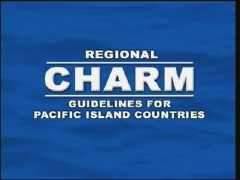Tiempo Climate Cyberlibrary
CHARM
- Tiempo archive
- Complete issues
- Selected articles
- Cartoons
- Climate treaty
- Latest news
- Secretariat
- National reports
- IPCC
About the Cyberlibrary
The Tiempo Climate Cyberlibrary was developed by Mick Kelly and Sarah Granich on behalf of the Stockholm Environment Institute and the International Institute for Environment and Development, with sponsorship from the Swedish International Development Cooperation Agency.
While every effort is made to ensure that information on this site, and on other sites that are referenced here, is accurate, no liability for loss or damage resulting from use of this information can be accepted.
|
|
The documentary Regional CHARM Guidelines for Pacific Island Countries describes the Comprehensive Hazard And Risk Management process for the Pacific islands. |
|
|
To watch the streaming video, you will need RealPlayer, a free download. |
|
The documentary was sponsored by the South Pacific Applied Geosciences Commission. It is made available here with permission. |
|
Currently, risk management activities in the Pacific tend to be limited to single government departments or regional organisations. In many instances, national risk reduction efforts are uncoordinated and in such cases duplication of efforts is common and planning gaps exist.
In order to address this situation, the South Pacific Applied Geosciences Commission (SOPAC) member countries have committed themselves to a more integrated Comprehensive Hazard And Risk Management - CHARM - process.
CHARM covers all hazards and is whole of country in orientation. It will enhance the sustainability of national development planning processes and encourage a more coordinated and integrated regional approach to risk reduction.
CHARM is modelled around the AS/NZS 4360-1999 Standard. It uses the Queensland design format, modified to suit Pacific region requirements.
CHARM moves the focus away from departments and agencies that support a wide range of non-coordinated activities towards a broader and integrated programming approach. This is achieved by aligning the CHARM process with National Strategic Development Plans.
The major goal of the CHARM model is to develop a national risk and treatment option matrix that has considered the activities of all agencies. CHARM targets the identified gaps in the matrix.
There are five main steps in the CHARM process.
- Establish the context
- Sensitize senior political and policy officials
- Identify strategic an organizational issues that will apply to the CHARM process
- Determine the CHARM management mechanisms and operational process
- Identify national development priorities
- Review existing policy related to development project appraisal processes
- Implement training to mainstream mitigation into this process
- Develop the initial risk evaluation criteria
- Identify risks
- Identify and assess primary and secondary hazards
- Identify vulnerable sectors and determine geographic scope of potential impact
- Identify risks associated with primary and secondary impacts
- Analyze risks
- Determine and assign levels of risk using indicators such as: How often are the hazards likely to occur? and, What are the potential consequences that may arise when the hazards impact?
- Assign levels of risk
- Evaluate risks
- Determine acceptable and unacceptable risks
- Rank risks in order of priority for treatment
- Treat risks
- Evaluate and select appropriate treatment sfor dealing with unacceptable risks
- Identify core business responsibilities and assess existing projects of agencies
- Develop and implementation process for the identified program gaps
- Link with Regional Partners and Programs
- Close the programming gaps through new project proposals
- Implement the new development program
The priorities for the successful implementation of CHARM are to advocate its adoption as a national risk management decision-making tool and to provide appropriate training and awareness through broad stakeholder consultation workshops involving both national and regional stakeholders.
CHARM will assist member countries to achieve one of the fundamental priorities of the ISDR strategy, which is to proceed from protection against hazards to the management of risks through the integration of disaster risk reduction into sustainable development.
Potential beneficiaries of CHARM will include all key stakeholders involved in disaster risk reduction including: government planning departments, national disaster management offices, non-governmental organizations, community groups, private sector, donors, and regional partners.
Guidelines for implementing the CHARM approach are available in printed form or on CDROM.
Further information
Atu Kaloumaira, Community Risk Programme Advisor, or Noud
Leenders, Risk Analyst - Community Risk Programme, SOPAC,
Private Mail Bag, General Post Office, Suva, Fiji, Email:
atu@sopac.org or
noud@sopac.org, Web:
www.sopac.org.
Bright Ideas

General Electric plans to cut solar installation costs by half

Project 90 by 2030 supports South African school children and managers reduce their carbon footprint through its Club programme

Bath & North East Somerset Council in the United Kingdom has installed smart LED carriageway lighting that automatically adjusts to light and traffic levels

The United States National Oceanic and Atmospheric Administration and the American Public Gardens Association are mounting an educational exhibit at Longwood Gardens showing the link between temperature and planting zones

The energy-efficient Crowne Plaza Copenhagen Towers hotel is powered by renewable and sustainable sources, including integrated solar photovoltaics and guest-powered bicycles
El Hierro, one of the Canary Islands, plans to generate 80 per cent of its energy from renewable sources

The green roof on the Remarkables Primary School in New Zealand reduces stormwater runoff, provides insulation and doubles as an outdoor classroom

The Weather Info for All project aims to roll out up to five thousand automatic weather observation stations throughout Africa

SolSource turns its own waste heat into electricity or stores it in thermal fabrics, harnessing the sun's energy for cooking and electricity for low-income families

The Wave House uses vegetation for its architectural and environmental qualities, and especially in terms of thermal insulation

The Mbale compost-processing plant in Uganda produces cheaper fertilizer and reduces greenhouse gas emissions

At Casa Grande, Frito-Lay has reduced energy consumption by nearly a fifth since 2006 by, amongst other things, installing a heat recovery system to preheat cooking oil
Updated: May 15th 2015
